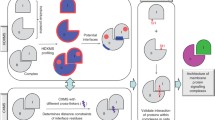Abstract
Disulfide bridges are essential for maintaining the structure and function of proteins. Traditionally, studies of the disulfide bonds require expensive equipment and high purity of the protein sample, therefore, the development of simpler techniques is warranted. Here, were present a novel protocol for the detection of disulfide bonds in proteins, which is based on the labeling reduced disulfide bridges with a high molecular weight (HMW) maleimide derivative. After irreversible blocking of free thiol groups of proteins, the labeling of new thiols released from disulfide bridges with a high-molecular-weight (HMW) maleimide derivative is performed. To confirm localization of cysteines involved in the formation of disulfide bonds, cysteine mutagenesis was conducted. For validation, aquaporin 5 (AQP5) and transient receptor potential cation channel subfamily V member 4 (TRPV4) proteins were tagged with FLAG (DYKDDDDK) on N-termini. Increase in MW of the target proteins from immunoblot indicated the presence of disulfide bonds. No bands with increased MW were detected in AQP5, while TPRV4 cysteines at disulfide bridges-constituting positions 639, 645, 652, 660, 770 were detected and confirmed by cysteine mutagenesis. These data indicate that the proposed technique is feasible and effective for the detection of protein disulfide bonds.





Similar content being viewed by others
REFERENCES
Bulaj G. 2005. Formation of disulfide bonds in proteins and peptides. Biotechnol. Adv. 23, 87–92.
Cook K.M., Hogg P.J. 2013. Post-translational control of protein function by disulfide bond cleavage. Antioxid. Redox Signal. 18, 1987–2015.
Goldberger R.F., Epstein C.J., Anfinsen C.B. 1963. Acceleration of reactivation of reduced bovine pancreatic ribonuclease by a microsomal system from rat liver. J. Biol. Chem. 238, 628–635.
Anfinsen C.B., Haber E. 1961. Studies on the reduction and re-formation of protein disulfide bonds. J. Biol. Chem. 236, 1361–1363.
Bonander N., Leckner J., Guo H., Karlsson B.G., Sjolin L. 2000. Crystal structure of the disulfide bond-deficient azurin mutant C3A/C26A: How important is the S–S bond for folding and stability? Eur. J. Biochem. 267, 4511–4519.
Wetzel R., Perry L.J., Baase W.A., Becktel W.J. 1988. Disulfide bonds and thermal stability in T4 lysozyme. Proc. Natl. Acad. Sci. U. S. A. 85, 401–405.
Hogg P.J. 2003. Disulfide bonds as switches for protein function. Trends Biochem. Sci. 28, 210–214.
Go Y.M., Jones D.P. 2013. Thiol/disulfide redox states in signaling and sensing. Crit. Rev. Biochem. Mol. Biol. 48, 173–181.
Tarnow P., Schoneberg T., Krude H., Gruters A., Biebermann H. 2003. Mutationally induced disulfide bond formation within the third extracellular loop causes melanocortin 4 receptor inactivation in patients with obesity. J. Biol.Chem. 278, 48666-48673.
Singh R. 2008. A review of algorithmic techniques for disulfide-bond determination. Brief. Funct. Genomics Proteomics. 7, 157–172.
Tsai C.H., Chan C.H., Chen B.J., Kao C.Y., Liu H.L., Hsu J.P. 2007. Bioinformatics approaches for disulfide connectivity prediction. Curr. Prot. Peptide Sci. 8, 243–260.
Singh R., Murad W. 2013. Protein disulfide topology determination through the fusion of mass spectrometric analysis and sequence-based prediction using Dempster–Shafer theory. BMC Bioinformatics. 14 (Suppl. 2), S20.
Planey S.L. 2012. Discovery of selective and potent inhibitors of palmitoylation. InTech. 9, 251–288.
Fontaine S.D., Reid R., Robinson L., Ashley G.W., Santi D.V. 2015. Long-term stabilization of maleimide-thiol conjugates. Bioconj. Chem. 26, 145–152.
Ravi S., Krishnamurthy V.R., Caves J.M., Haller C.A., Chaikof E.L. 2012. Maleimide-thiol coupling of a bioactive peptide to an elastin-like protein polymer. Acta Biomater. 8, 627–635.
Ghosh S.S., Kao P.M., McCue A.W., Chappelle H.L. 1990. Use of maleimide-thiol coupling chemistry for efficient syntheses of oligonucleotide-enzyme conjugate hybridization probes. Bioconj. Chem. 1, 71–76.
Singh R., Whitesides G.M. 1994. Reagents for rapid reduction of native disulfide bonds in proteins. Bioorg. Chem. 22, 109–115.
Ding Q.W., Zhang Y., Wang Y., Wang Y.N., Zhang L., Ding C., Wu L.L., Yu G.Y. 2010. Functional vanilloid receptor-1 in human submandibular glands. J. Dental Res. 89, 711–716.
Nordlund H.R., Laitinen O.H., Uotila S.T., Nyholm T., Hytonen V.P., Slotte J.P., Kulomaa M.S. 2003. Enhancing the thermal stability of avidin. Introduction of disulfide bridges between subunit interfaces. J. Biol. Chem. 278, 2479–2483.
Carugo O., Cemazar M., Zahariev S., Hudaky I., Gaspari Z., Perczel A., Pongor S. 2003. Vicinal disulfide turns. Prot. Eng. 16, 637–639.
Caterina M.J. 2007. Transient receptor potential ion channels as participants in thermosensation and thermoregulation. Am. J. Physiol. Regul. Integr. Comp. Physiol. 292, R64–R76.
Wang S., Chuang H.H. 2011. C-terminal dimerization activates the nociceptive transduction channel transient receptor potential vanilloid 1. J. Biol. Chem. 286, 40601–4067.
Deng Z., Paknejad N., Maksaev G., Sala-Rabanal M., Nichols C.G., Hite R.K., Yuan P. 2018. Cryo-EM and X-ray structures of TRPV4 reveal insight into ion permeation and gating mechanisms. Nat. Struct. Mol. Biol. 25, 252–260.
Duan J., Li J., Zeng B., Chen G.L., Peng X., Zhang Y., Wang J., Clapham D.E., Li Z., Zhang J. 2018. Structure of the mouse TRPC4 ion channel. Nat. Commun. 9, 3102.
ACKNOWLEDGMENTS
We are grateful to Prof. Miguel A. Valverde (Universitat Pompeu Fabra, Barcelona, Spain) for his generous gifts of plasmids and to Prof. Xiaomin Wang (Capital Medical University, Beijing, China) for assistance with the lab equipment.
Funding
This study was supported by grants from the National Nature Science Foundation of China (nos. 81100765, 81570990).
Author information
Authors and Affiliations
Contributions
The text was submitted by the author(s) in English.
Corresponding author
Ethics declarations
The authors declare that they have no conflict of interest. This article does not contain any studies involving animals or human participants performed by any of the authors.
Rights and permissions
About this article
Cite this article
Ding, Q.W., Lin, M. Protein Disulfide Bonds Detected by Tagging with High Molecular Weight Maleimide Derivative. Mol Biol 55, 449–457 (2021). https://doi.org/10.1134/S0026893321020187
Received:
Revised:
Accepted:
Published:
Issue Date:
DOI: https://doi.org/10.1134/S0026893321020187




